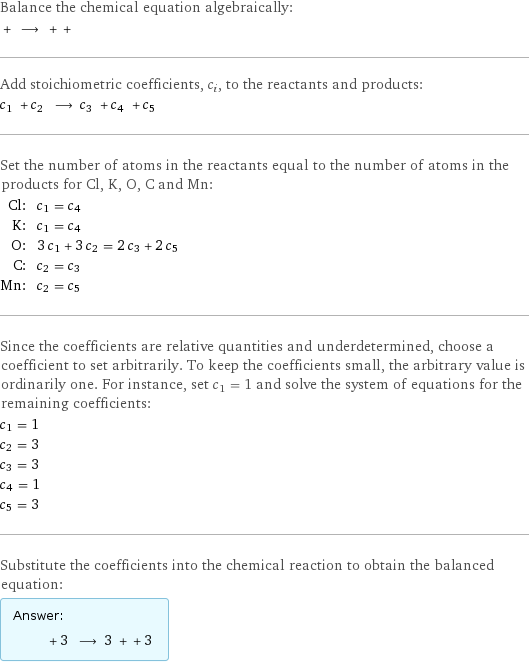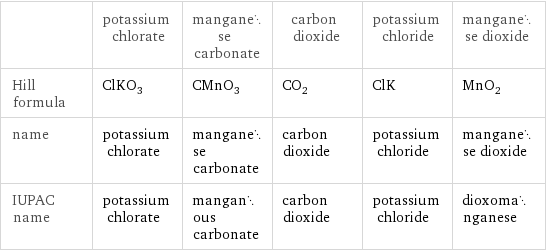Input interpretation

potassium chlorate + manganese carbonate ⟶ carbon dioxide + potassium chloride + manganese dioxide
Balanced equation

Balance the chemical equation algebraically: + ⟶ + + Add stoichiometric coefficients, c_i, to the reactants and products: c_1 + c_2 ⟶ c_3 + c_4 + c_5 Set the number of atoms in the reactants equal to the number of atoms in the products for Cl, K, O, C and Mn: Cl: | c_1 = c_4 K: | c_1 = c_4 O: | 3 c_1 + 3 c_2 = 2 c_3 + 2 c_5 C: | c_2 = c_3 Mn: | c_2 = c_5 Since the coefficients are relative quantities and underdetermined, choose a coefficient to set arbitrarily. To keep the coefficients small, the arbitrary value is ordinarily one. For instance, set c_1 = 1 and solve the system of equations for the remaining coefficients: c_1 = 1 c_2 = 3 c_3 = 3 c_4 = 1 c_5 = 3 Substitute the coefficients into the chemical reaction to obtain the balanced equation: Answer: | | + 3 ⟶ 3 + + 3
Structures

+ ⟶ + +
Names

potassium chlorate + manganese carbonate ⟶ carbon dioxide + potassium chloride + manganese dioxide
Equilibrium constant
![K_c = ([CO2]^3 [KCl] [MnO2]^3)/([KClO3] [MnCO3]^3)](../image_source/df2c564d52fd0d9bd1880231d3e022a7.png)
K_c = ([CO2]^3 [KCl] [MnO2]^3)/([KClO3] [MnCO3]^3)
Rate of reaction
![rate = -(Δ[KClO3])/(Δt) = -1/3 (Δ[MnCO3])/(Δt) = 1/3 (Δ[CO2])/(Δt) = (Δ[KCl])/(Δt) = 1/3 (Δ[MnO2])/(Δt) (assuming constant volume and no accumulation of intermediates or side products)](../image_source/0e2aeaa22860bcb91f8c36d3e2ead640.png)
rate = -(Δ[KClO3])/(Δt) = -1/3 (Δ[MnCO3])/(Δt) = 1/3 (Δ[CO2])/(Δt) = (Δ[KCl])/(Δt) = 1/3 (Δ[MnO2])/(Δt) (assuming constant volume and no accumulation of intermediates or side products)
Chemical names and formulas

| potassium chlorate | manganese carbonate | carbon dioxide | potassium chloride | manganese dioxide Hill formula | ClKO_3 | CMnO_3 | CO_2 | ClK | MnO_2 name | potassium chlorate | manganese carbonate | carbon dioxide | potassium chloride | manganese dioxide IUPAC name | potassium chlorate | manganous carbonate | carbon dioxide | potassium chloride | dioxomanganese